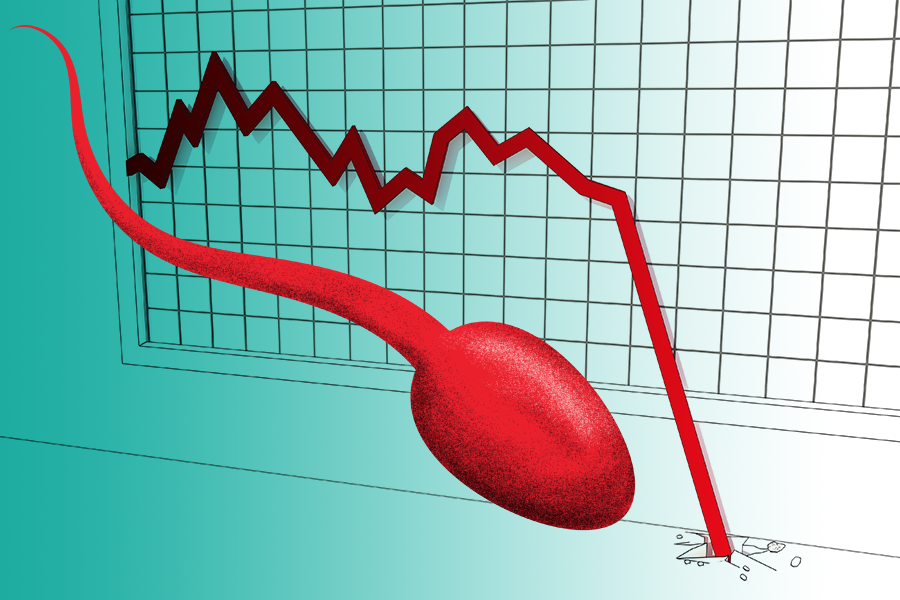The state of male infertility in the Western world has been called a full-on “crisis” by practically every media outlet publishing on the internet (and on paper). More specifically — and scientifically — per Brian Levine, the practice director at the Colorado Center for Reproductive Medicine and a board-certified OB-GYN, infertility affects one in eight couples. And within that population, 40 percent of those experiencing fertility problems are male. Some of the popular culprits for less-than-stellar modern sperm: Everything from processed meats to resting your laptop on — you guessed it — your lap.
When I call and ask Levine about how we reverse this trend — are we talking about a gigantic public health campaign that would eliminate both processed meats and forbid you from ever placing your laptop on your balls again? — he points to a new Italian study on the bacterial climate of the testicles. In fact, he tells me that it’s “one of the most exciting advances in the field of male fertility.” Needless to say then, my questions didn’t stop there…

What about this study makes it such an “exciting” advancement?
Let’s talk about what we’re calling the microbiome. How we process what we eat is just as important as what we eat when it comes to the body’s bacteria. How you process your food and nutrients informs the type of bacteria that lives within your gut and within your body. For example, we’ve long known that babies that are born by vaginal delivery as opposed to cesarean tend to be healthier in the early childhood years, and the thought is that it’s due to exposure and colonization from the vaginal microbiome.
What’s interesting about the studies that are coming out about the testicular microbiome is the suggestion of an issue occurring in the male reproductive tract related to the cohort of bacteria found in the testicle. What we don’t understand about this is a basic chicken-or-egg scenario: We don’t know if men having poor testicular function and lacking sperm is the result of this microbiome, or if men who have poor sperm and semen parameters have altered their microbiome.
So that’s where the research is at right now — determining the order of these factors?
This will hopefully lead to the question of how can we take a sample of a guy’s semen — either with a needle or via ejaculate — to get a good idea of what’s going on anatomically and biochemically for this man. The future of medicine isn’t exposing someone to the risks of surgery and complications of surgery. The future of medicine is non-invasive testing, and I like how this study gives us a chance to look at male infertility non-invasively.
All of my research in the past is in sperm morphology, which is subjective. I’m intrigued by this new research because, if we now have a non-invasive therapeutic target, which is altering the microbiome, we might need to give these men probiotics or different supplements as a central part of their treatment.
What do you typically consider when evaluating a man’s fertility?
A lot of people don’t realize how complicated male fertility can be. When a man gets evaluated for his “fertility,” we look for a few quick things: One is volume. How much semen does he produce? Two is the concentration. How many sperm does he produce? Three is the motility. How well do they swim? Four is the sperm shape.
Out of the four things I listed, the shape is the most subjective. How many look normal? How many look abnormal? We have standards that we use from the World Health Organization, but judging sperm shape is like judging a piece of artwork. It’s open to interpretation. So it’s hard to judge men based on the shape of their sperm, but it’s one of the primers we use.
Other men don’t have any sperm. We call this Azoospermia. This is usually caused by an obstructive blockage. The patient was either born with a blockage, like men with cystic fibrosis, or he had a blockage as a result of a surgery. Did the guy have a vasectomy? Or is this nonobstructive? This is when all of his plumbing works in the right way, but he still doesn’t make sperm. Over the years, we’ve started to look at other characteristics of that semen sample among nonobstructive cases — things like PH. When people with vaginas take antibiotics, they’ll sometimes get a yeast infection because the antibiotics change the bacteria within the vagina, which changes the PH. PH allows the yeast to grow. For men with nonobstructive azoospermia, alterations in the PH are present. As a result, the testicular microbiome is different.
All of this is to say, the microbiome of the testicle is unfortunately under-studied. We’ve known for years that alteration of the microbiome in the vagina has altered effects on fertility and vaginal health. Now, we need to determine if the same is true of men.
What about the idea that consuming ibuprofen may be linked to male infertility?
Truth be told, I think this correlation is because men who are taking lots of ibuprofen likely have a couple of issues. One is they’re working out a lot, and they need it for their muscle aches and joint pain. Also, we know men who exercise a lot have decreased fertility because of the increase in the temperature of their testicles and scrotum. Number two, men who take lots of ibuprofen might not be well. They may not be healthy people, and we know that a good fertility barometer is someone’s general health.
What about this idea that eating lots of nuts could also help with male fertility?
That applies for men and women. All the hormones made in the body are made through through cholesterol, and cholesterol is the backbone of almost every reproductive hormone in men and women. In fact, testosterone and estrogen are related by simple enzymatic conversions. So studies have shown that men who consume more nuts have better semen parameters in regards to fertility, which is probably related to the fact that they have a better hormonal profile.
But again, who are the people eating more nuts? Those are likely healthy people. So is this association or correlation? That’s the hard part to figure out.
What’s your advice then for men concerned about their own fertility?
It’s plain and simple: Talk to your doctor. I cannot tell you how many times people have had a suggestion or a feeling that something was awry, but they don’t get checked out. There’s no shame in going to see a fertility doctor or getting a semen analysis done. And if you don’t want to do that, go with your partner to their OB-GYN and ask for advice. The truth is, infertility is common. One in eight is a huge number, and it’s related to men just as often as it’s related to women. The problem is that more often than not infertility goes unrecognized and under-treated.
When in doubt, there’s no harm in getting a simple check-up. There’s no needles. There’s no pain. There’s nothing. It’s just giving a semen sample. There are some at-home tests as well. You can go to the pharmacy and buy one. Now, they’re not the best, but they’re at least a good starting point to get the conversation flowing about whether everything is okay down there.

